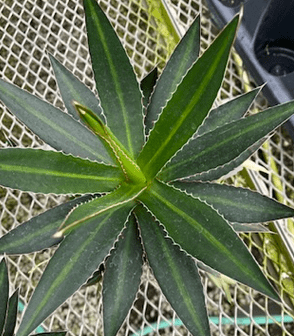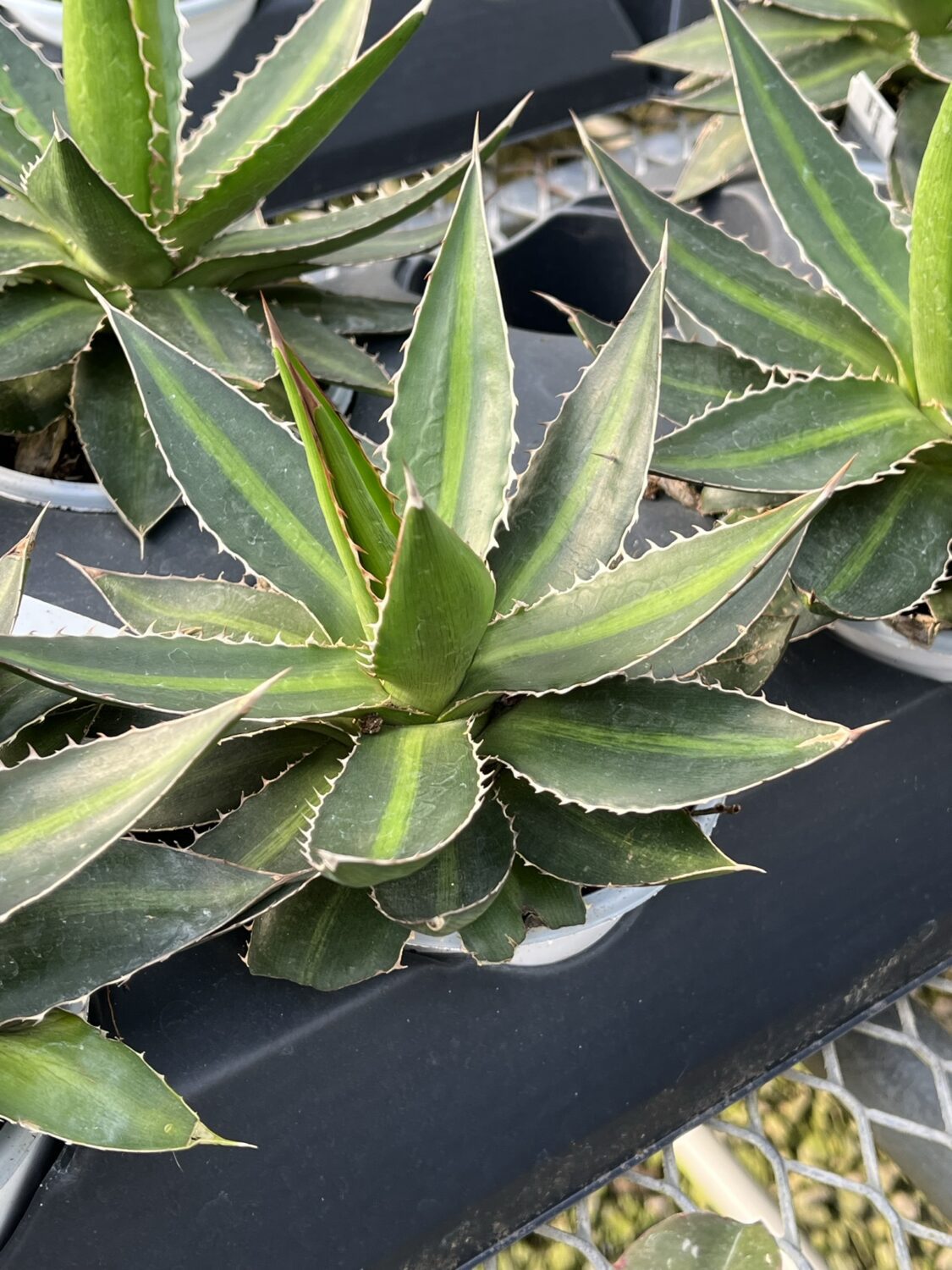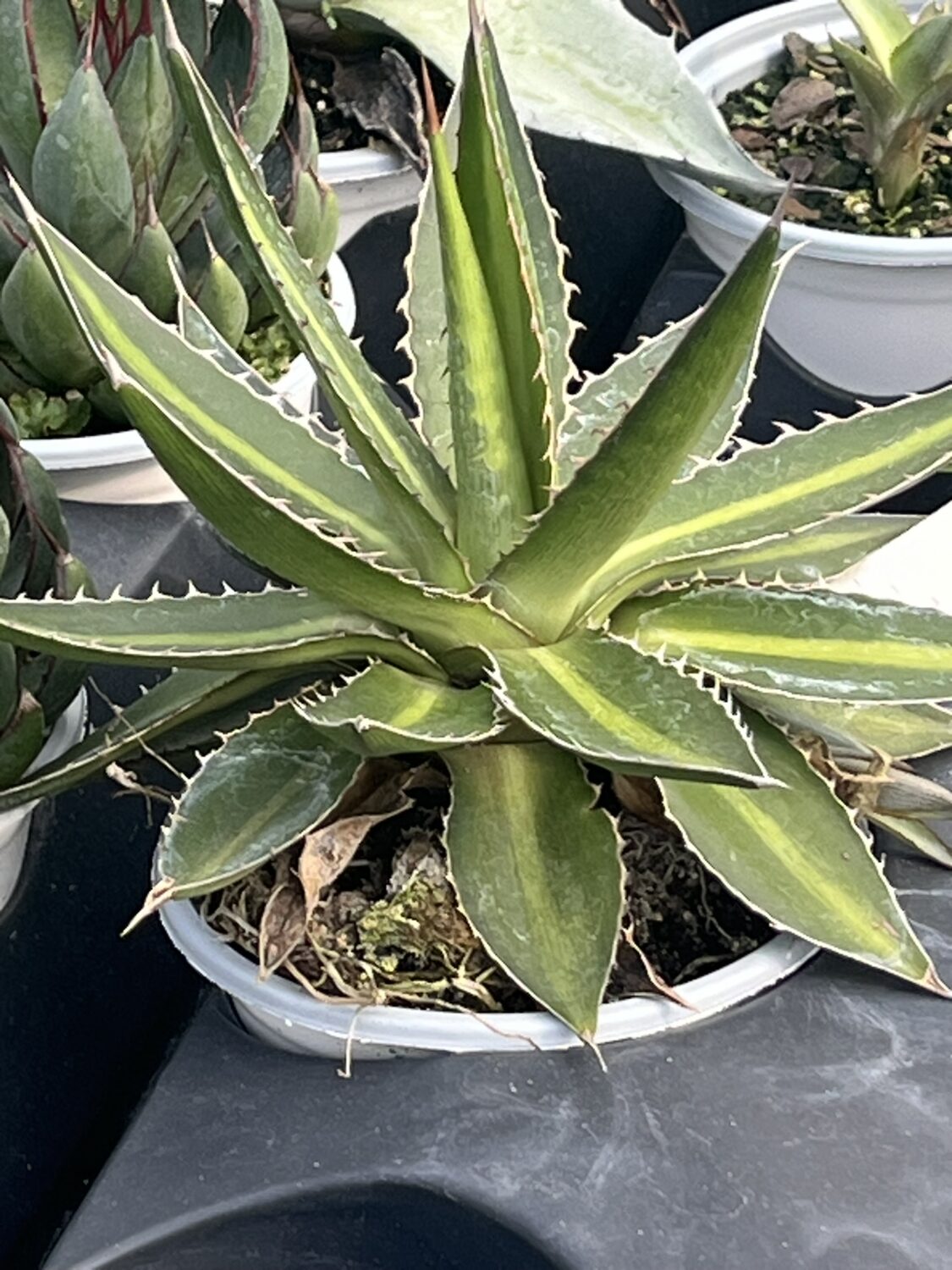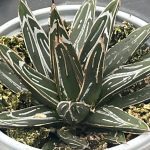Agave lophantha, Splendida
Price range: $6.99 through $24.99
Zone 9+
Description
Agave lophantha ‘Splendida’: A Striking Variegated Century Plant
Agave lophantha ‘Splendida’ is a bold and architectural succulent, prized for its striking variegation and compact size. Its sword-like leaves feature deep green centers edged with creamy yellow margins and tiny teeth along the sides, creating a dramatic starburst form. Perfect for containers, rock gardens, and xeriscapes, this agave thrives in sunny, dry locations and adds year-round structure to landscapes with minimal care.
This guide explores everything you need to know about Agave lophantha ‘Splendida’ — from its distinctive appearance to planting, care, and creative uses in modern and drought-tolerant gardens.
Distinctive Variegation and Form
‘Splendida’ forms a symmetrical rosette about 1 to 2 feet tall and 2 to 3 feet wide. Each stiff, lance-shaped leaf is dark green with bright yellow or cream margins, often highlighted by sharp, reddish-brown spines along the edges and a strong terminal spine at the tip.
This high-contrast variegation makes it a standout among agaves, offering bold texture and color to both minimalist and lush garden designs.
Growth Habit and Lifecycle
Like other agaves, ‘Splendida’ is a monocarpic perennial — it flowers once at maturity, producing a tall bloom stalk (often 10–15 feet tall) with clusters of yellowish-green flowers that attract pollinators. After flowering, the main rosette dies, but offsets (pups) around the base continue the plant’s life cycle.
Growth is moderate, making it suitable for containers and smaller landscapes where larger agave species might overwhelm.
Best Growing Conditions
Sunlight
Thrives in full sun, requiring at least 6–8 hours daily for best color and form. Can tolerate light shade, but variegation may be less vivid.
Soil
Prefers well-drained, sandy or rocky soil. Avoid heavy clay or water-retentive soils, which can cause root rot. In containers, use a cactus or succulent mix with added grit or pumice for drainage.
Temperature and Hardiness
- Hardy in USDA zones 8–11.
- Tolerates light frost down to about 10–15°F with dry soil.
- In colder regions, grow in containers and bring indoors during winter.
Watering Needs
‘Splendida’ is drought-tolerant once established. Follow the “soak and dry” method:
- Water deeply, then allow soil to dry completely.
- Water sparingly in winter when growth slows.
Overwatering is the most common cause of problems; it’s better to err on the dry side.
Fertilizing
Feed lightly in spring and summer with a low-nitrogen succulent fertilizer to support steady growth and vibrant variegation. Avoid excessive fertilizer, which can cause weak, floppy leaves.
Planting and Spacing
- In-ground planting: Space 2–3 feet apart to allow the rosette to expand.
- Container planting: Choose a wide, shallow container with excellent drainage holes.
- Mulching: Use gravel or small stones rather than organic mulch to prevent rot.
Pruning and Maintenance
Minimal pruning is required:
- Remove dead or damaged leaves at the base using gloves and long-handled tools to avoid spines.
- After flowering, cut away the spent bloom stalk and remove the mother plant if offsets are present.
Regularly check for pups around the base — these can be left to form a clump or removed for propagation.
Propagation
Easily propagated from offsets (pups):
- Separate pups from the mother plant when they are at least 1/3 the size of the parent.
- Allow the cut end to callus for 1–2 days.
- Plant in well-draining soil and water lightly until established.
Pests and Problems
Generally low-maintenance, but occasionally affected by:
- Agave snout weevil: Can bore into the plant’s crown. Prevent by inspecting regularly and removing affected plants.
- Root rot: Caused by poorly draining soil or overwatering.
- Scale insects: Rare; treat with horticultural oil if noticed.
Design and Landscape Uses
Agave lophantha ‘Splendida’ is ideal for:
- Rock Gardens and Xeriscapes: Complements other drought-tolerant plants like yucca, dasylirion, and ornamental grasses.
- Containers: Striking focal point for patios and entryways.
- Modern Landscapes: Pairs well with gravel, stone, and minimalist plantings.
- Accent Planting: Use as a bold specimen in borders or massed with other agaves for a sculptural effect.
Color Pairing Ideas
- Combine with silver or blue succulents (e.g., Echeveria, Agave parryi) for contrast.
- Pair with flowering perennials like red yucca (Hesperaloe) or salvia for seasonal color.
- Surround with ornamental gravel or decomposed granite to highlight its shape and variegation.
Seasonal Care
- Spring/Summer: Active growth; water moderately and feed lightly.
- Fall/Winter: Reduce watering; protect from excessive moisture and hard freezes.
- Flowering Year: Allow bloom stalk to develop; remove mother rosette after flowering to encourage offsets.
Why Gardeners Love It
- Compact size suits small spaces and containers.
- Striking variegation adds year-round interest.
- Extremely drought- and heat-tolerant.
- Minimal care and maintenance once established.
- Provides bold architectural structure in any garden style.
A Splendid Star for Dry Gardens
Agave lophantha ‘Splendida’ lives up to its name, delivering bold color and form that stands out in any sunny garden. Its variegated leaves, manageable size, and rugged resilience make it a favorite for modern xeriscapes, desert gardens, and container plantings alike.
Whether grown as a focal point in a minimalist landscape or paired with other succulents for a dynamic display, ‘Splendida’ offers lasting beauty with very little effort — a true gem for water-wise gardeners.
Additional information
| Weight | N/A |
|---|---|
| Dimensions | N/A |
| Options | 2.5 in. (7.8 fl.oz.) Potted Plant, 4 in. (16.9 fl. oz.) Pot, 6 inch (2.5 quart) Pot |




